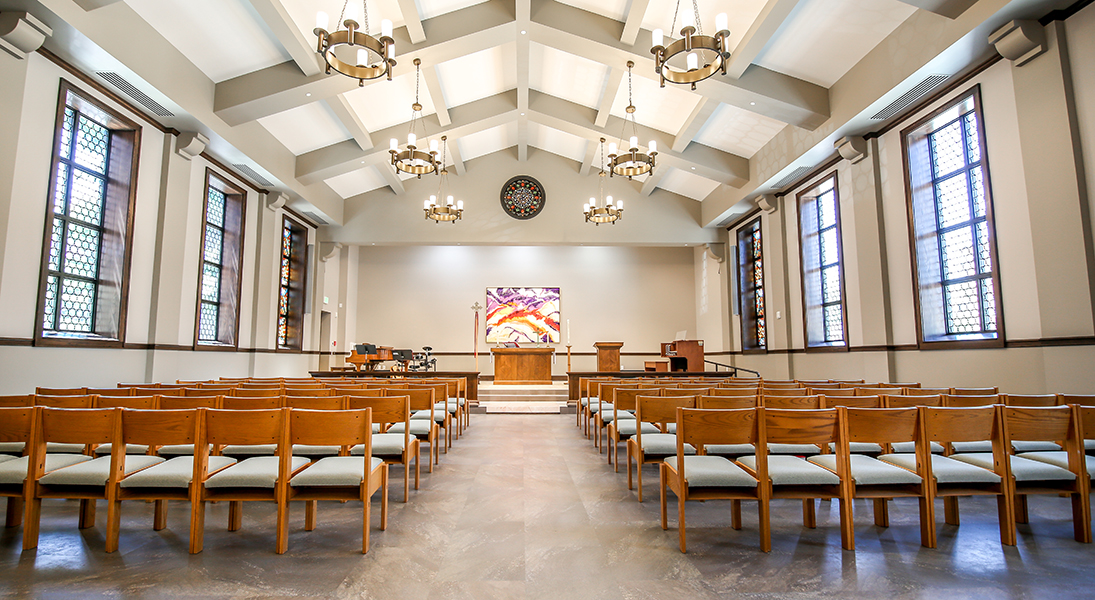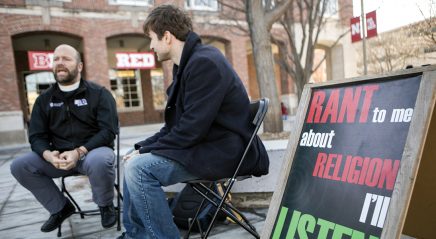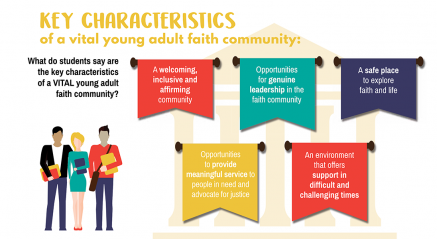When Adam White became pastor of the Lutheran Center at the University of Nebraska–Lincoln in 2011, he inherited a thriving campus ministry—and a deteriorating building.
“The building was originally built in 1952, and it was clear that, by the 1960s, there [had been] significant maintenance problems that had to be addressed through the cheapest means possible,” he said. “It was a duct-tape approach—in some places, literally.”
There was severe termite damage throughout the building, the original pipes had broken down and the sanctuary ceiling leaked whenever there was rain or snow. White invited someone to inspect the roof and provide a quote for repairs, but the contractor ultimately said that he couldn’t without tearing off many layers of roof patching and assessing the structural damage.
Ministry leaders knew they would have to take significant action. They also wanted the Lutheran Center’s physical space to reflect the campus ministry’s bright future and its solid history since 1919.
For many years the center’s upper level had served as housing. Historically, White explained, it was reserved for married graduate students who also maintained the building. But the arrangement hadn’t been operating particularly well because few of these students had the necessary skills.
“We didn’t really think that was the best way to do management anymore,” White said. “But we also knew that the people who’d lived in the building had a deep experience of the ministry and faith development.”
So, as they considered what to do about their deteriorating structure, ministry leaders also entertained the possibility of providing living space for more students and developing an intentional community.
“We also recognized that the residential component could be a revenue stream that could help solidify funding for the next several decades,” he said.
White brought the building issues to the governance council, and all agreed that the best way forward was to build a new structure in the old one’s place. In 2015 they initiated a capital campaign to raise $6 million for the new building. They started their fundraising campaign by reaching out to those who could personally testify to the significance of the campus ministry.
“My predecessors saw campus ministry funding would shift, so as early as the ‘60s they started keeping an alumni list and maintaining that database,” White said. “A gift I received when I walked in was those 9,000 names. The ministry here had a substantial impact on people for decades, and my predecessors had maintained those connections well, so we had a really strong base of alumni and supporters to begin with, which was huge.”
Campus ministry leaders connected with granting agencies, and funds came in from congregations around the state. “Numerous small congregations made generous gifts proportionate to their size,” White said. “They really believe the mission of campus ministry is needed in the life of the church.”
During a key moment in the construction process, when material costs increased, ministry leaders worried they’d hit an impasse, but with a major gift from the Nebraska Synod—and a challenge from the synod to congregations to match it—the campus ministry met its goal.
“We hit $6 million,” White said. “It was a remarkable thing—completing the project with no debt.” The new Lutheran Center opened in December 2020 and was dedicated last August, at the beginning of the school year.
Home away from home
Central to the concept of the new building is the “Upper Room,” which provides living space for an intentional community of 11 people who agree to uphold a set of covenants.
White said the covenants emphasize faith, vocation and advocacy, and the students build a curriculum they want to study and work on throughout the year. They must commit to attending the Upper Room’s weekly shared meals and meetings, and there is also an expectation that they will be involved in regular spiritual practice and hold each other accountable.
“If I’m not in class, I’m at the Lutheran Center, so I have really enjoyed having this space as my home away from home.”
Senior Lauryl Hebenstreit lives in the Upper Room and serves as its resident director. Part of her role is to make sure the community upholds the promises laid out in the covenants, conceives and communicates about projects, and implements restorative-justice tactics when problems arise in the residence. The students living in the Upper Room this year have committed to advocacy work on the theme “God’s living creation.”
Hebenstreit said the Upper Room has given people the opportunity to deepen relationships with their peers.
“It’s really nice because the covenants kind of lay the field of play for the community,” she said. “It makes it easier as you’re getting to know each other because you can say, ‘These are the ways—mind, body and spirit—that we are going to be present, and these are the ways we address issues when things go wrong.’”
The sense of community fostered by the center’s new space extends well beyond the students who live there. White said university faculty have used it for meetings and retreats, and there have been a lot more students and parents stopping by to request tours.
Junior Hannah Molskness was active in her ELCA youth group growing up, and she connected with the campus ministry during her freshman year, when the center was still under construction. Having the new building, she said, allows for more ministry outreach, and it is catching the interest of more students.
“The new space has made it easier to have that presence and be that welcoming group,” she said. “As a student, I am here all day, every day, pretty much. If I’m not in class, I’m at the Lutheran Center, so I have really enjoyed having this space as my home away from home.
“Every time I walk into this building, whether I’m ready for a new day or I’m frustrated about something, I know there is a sense of peace and community that is willing to hear out any problem I’m having.”
White said he’s grateful not only for how the campus community has gathered in the new Lutheran Center but also for how the wider church united to build it.
“What’s remarkable … is the way the church came together to get this done. Not just alumni but a swell of support throughout the Nebraska Synod and across an even broader footprint that decided this was important enough to do. For me, that’s a really important story because there are a lot of places the church isn’t investing in campus ministry, and to have congregations and synods come together and say ‘We want this to thrive’ has been humbling and deeply inspiring for me.”










